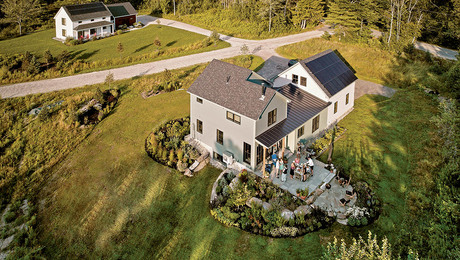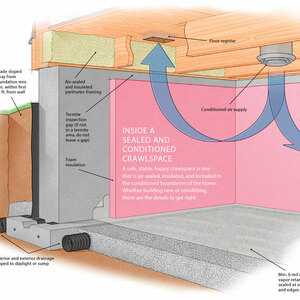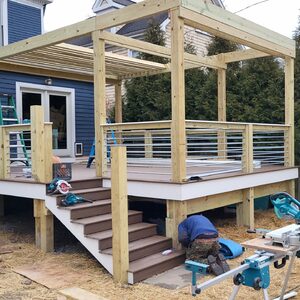Discussion Forum
A co-worker asked me to take a look at rotting kick boards beneath 2 doors on the back of his 5 year old, 2 story home located in central Maine. The kick boards were 1×12 pine and the doors are located directly below an unguttered roof with an overhang of approximately 4″. Both doors have granite steps leading into the house.
Both of the kick boards were severely rotten, one horribly so. When I removed the worse of the two I found the OSB siding behind the kick board was like mush – comletely rotten. Behind the OSB, a portion of the LVL band joist (roughly 2 sq ft) is also somewhat rotten. The band joist looks to be approx. 1.5″ thick and the outer 1/4″ to 1/2″ is wet and very soft. From the inside of the home, the band joist looks fine. This portion of the band joist is located directly under a sliding glass door, so presumably it is not carrying a significant load.
My question is whether or not we should replace the wet section of band joist or just let it dry out before replacing the pine with a pressure treated 2×12?
Thanks in advance!
Sco
Discussion Forum
Up Next
Video Shorts
Featured Story

By considering things like energy-efficient mechanicals, window orientation, and renewable energy sources, homes can be evaluated to meet the energy codes. Here's what the IRC has to say.
Highlights
"I have learned so much thanks to the searchable articles on the FHB website. I can confidently say that I expect to be a life-long subscriber." - M.K.

















Replies
If it is true Rim Board or an LVL, you CANNOT replace it with a 2x12 of any sort. Rim and LVL are engineered products with specific dimensions that don't change. A 2x12 will shrink as it dries.
The solution here doesn't require a more water resistant band joist - it requires fixing the water penetration problems. You need to fix the flashing details and redirect that water, or implment a rainscreen of some kind over that wall
it's located under or near a door, might behoove removing, waterproofing/panning the opening and then re-install the door.
If all that mush had concrete poured up against it, water entry there might be the cause and should be dealt with.
If we cut out the rotting Rim Board, we'll replace it with the same. We're using the 2x12 PTL to replace the pine kick board that was in place.
As far as fixing the water penetration problem, I did recommend the home owners install gutters. They told me that the builder was adamant that they don't install gutters. The builder told them that they would be torn off the house during the first winter...
I dislike gutters too, for various reasons, but this is a case where they are definitely called for. The scenario you describe is one of the most common rot fixes I am called to do. That rot is not accidental - it is CAUSED! The splash back off the stoop is leeping that area wet. At the very least, rain diverters are needed.
I just had a similar situation. Entry system with center door and two sidelights. Standard construction on this one. Leaking at the sidelight joints. Subfloor was damp at those areas but not real bad. I left it, used Grace I&W and an aluminum pan. Here in maine, carpenter ants like these areas and can make quite a mess. You'll have to make the call about replacing depending on your conditions. If mine was much worse, I would have replaced.
man Hammer...........
that first pic looks like I left my tools there.
Do you make any attampt to dry out the existing wet wood?
At the very least we are going to let the wet wood dry out before covering it. We haven't had much dry weather since uncovering the mess...
it's the granite step causing the rain to bounce back on the house and the dooor sill that rots everything in that area. We make that repair pretty often. I cover all the new work with bithumen including the rough door jambs up about 2 feet.
That is what I suspected and I recommened that the homeownwer install gutters to cut down on the rain bouncing back onto the door sill. I wondered about installing bitumen on the band joist, but in a mid Maine climate I am concerned about moisture escaping from the home and condensing on the band joist - leading to more rot. I do wonder if that is a legitimate concern???
I wish I had time to dry out the wet spots on my job but we kept the original door, replaced the door jamb and threshold and replaced the steel side lights with fiberglass ones. The new assembly didn't quite fit the rather tight RO and made for extra work. I needed to do the job in one day and not leave the side of the house open. Best I could do was blow my heat gun on the damp spots for a little while. Fortunately, the wetness was only in two small spots and I felt confident the new attention to potential leaking would take care of things in a while.
I think it's quite unlikely that condensation from inside will cause any issues unless there was little or no insulation and vapor barrier. That isn't the case on this house. The splash off the steps as well as leaks at joints are more of a concern to me. There are good working gutters on the house but that doesn't stop rain from driving against the house or bounching off the steps. The new work should end or reduce those problems for many years, more with proper maintenence. The new jambs are pressure treated, Auralast, and the new trim work is Aztek. Reading the warranty on the Aztek took me back since it's only for 25 yrs. The original white pine trim and jambs lasted almost that long at 1/4 the price. I'm not sure what will happen to the Aztek in 25 yrs, melt away, LOL?
As I said before, if my job had been soaked through the layers of plywood or carpenter ants had taken up residence, I would have replaced everything that was effected. My damage was limited to the top two veneers of plywood just under the sidelight joints and nothing on the rim joist sheathing, nothing on the rim joists themselves, which are standard framing lumber. The house was built in 1980, 32 yrs. is pretty good, longer than the insulated glass in the sidelights will last. If you have the slightest doubt, replace properly.
PS, properly installed gutters are not a problem in Maine with asphalt roof shingles as long at the ceiling is well insulated and the roof completely ventilated. They will fill with ice but ice dams shouldn't be severe with proper insulation and ventilation. Of course, at least one row of Ice and Water sheild are a must under the shingles. Insulation means R40 minimum, continuous ridge and soffit vents. Metal roofs can release a lot of snow, which we get plenty of, and take off gutters that are installed too high and not well secured. Continuous aluminum gutters are fine but those plastic ones with lots of joints and plastic hangers are a waste of money up here. Roof pitch, width of overhang along with valleys and other roof construction details also have their impact. The answer on gutters is, it depends, but with the deep and long frost we have, keeping as much water away from the foundation as possible is very important. Foundations are not easy or cheap to fix.